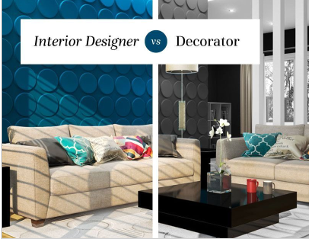There is often confusion between the terms interior designer and interior decorator. Maybe you’re also unsure and looking for clear answers. Most of us only know we need several creative ideas to make our home more astonishing. For this reason, we may not know whether to hire an interior designer or a decorator. Then you must know the difference between an interior designer and an interior decorator. Interior designers are technically different from interior decorators. Understanding the difference is a complicated process that requires technical expertise and few technical skills.
List of Differences between an Interior Designer and an Interior Decorator
Occasionally, interior designers and interior decorators are used synonymously. However, in reality, they have separate job descriptions and duties. Designers work to meet the needs of people and design functional, structural living, or working spaces. In contrast, decorators furnish interior spaces with furniture and accessories. Designers must have a license to practice and provide their services, whereas decorators are not required to have one. The fact is that interior designers can offer both designing and decorating services, whereas decorators can only offer decorating services. There are other differences between an interior designer and an interior decorator. We have provided several examples of such notable differences so that you will be able to rectify the discrepancy between the two.
Definition
Interior design is a vast place that covers the art and science of creating usable spaces in a home by knowing how people behave. But the decorators are only devoted to decorating a given area with unique creative ideas. Their job is to decorate or embellish a room with decorative elements to achieve optimum aesthetics. Designers focus on the overall design of a room, while interior decorators do not.
Position Description
Interior designers often seem to collaborate with architects. They do this only to implement changes to the structure of the interior based on their interior design plans. They have a thorough understanding of building codes and have lots of experience working with construction. But the decorators are not with any such collaboration with architects. Their role involves creating new decorative touches using their creativity to enhance the existing space. They work with color schemes of existing spaces to make them aesthetically pleasing by decorating an area or living space with attractive or fashionable objects.
An interior designer designs living spaces or workspaces to meet clients’ needs. It is a designer’s responsibility to tackle complicated structural issues so that residents have a better quality of life. On the other hand, interior decorators handle the aesthetic needs of a client. They transform existing spaces into something more astonishing and functional. They often paint walls, replace or redecorate old furniture, even select new furniture, set up window coverings, put wall hangings or other accessories like lamps, rugs, flower vases, paintings, and so on.
Schooling:
A career in interior design requires specialized education and formal training. Some of the responsibilities of interior designers include color and fabric research, computer-aided design (CAD) training, drawing, space planning, furniture design, and architecture. Most interior decorators possess college degrees in related fields, although not compulsory. Interior decorators do not need formal training to practice their profession. They are primarily concerned with aesthetics rather than renovations or structural planning. As part of the planning and design process, a decorator comes in to focus on the surface appearance of a space.
Licenses and Certificates
Many countries focus on registering and availing licenses for practice as interior designers. For example, in many US states, practicing interior designers are even required to earn an official NCIDQ Certificate to demonstrate their expertise. The law requires designers to provide proof of their educational achievements, including diplomas and training certificates. In many parts of the world, a professional designer must pass an exam and meet a minimum requirement to be registered with the relevant authority. There are, however, a lot of places that don’t require credentials.
Nevertheless, interior decorators do not require formal training to become interior decorators. Instead, there are a number of programs and courses available to get professional expertise in this field. For decorators seeking to validate their work, organizations like C.I.D. (Certified Interior Decorators International) offer coursework and certification. In addition to color and fabric, these courses usually cover room layouts, furniture styles, and space planning.
Payscale
Earnings of interior designers differ based on the level of education they have, such as a Bachelor’s or Masters. Hence, starting pay for interior designers and decorators varies greatly. Indeed.com estimates that the average annual salary for an interior designer in the United States is 57,559 dollars. As per the same, decorators charge about $100-$200 an hour. Both interior designers and decorators have a wide range of payscales based on the place and their experience.
Conclusion
Now that you know the difference between an interior designer and an interior decorator, you can decide which one you would like to hire. Nevertheless, you can readily determine who to call to meet your needs. Therefore, if you are looking for an interior designer, you will have to consider your taste, budget, and schedule, as well as the current state of your interior. When evaluating your needs, if you realize that your job requires complicated coordination with several associated departments, you should consider hiring an interior designer. If you want to reorganize your existing room to make it more appealing, then you need the creative touch of an interior decorator.
There are good employment opportunities and good salaries in either interior design or interior decoration. A career in interior design offers students and aspiring designers an opportunity to explore a realistic career with global opportunities. However, if you have an artistic eye, you can become a decorator after a couple of certificates. Take your time and do your research before committing to anything. We hope you have enough knowledge of the differences between a designer and a decorator by then.

